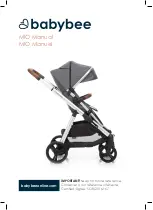Reviews:
No comments
Related manuals for NCC-1

C Series
Brand: Nelsen Corporation Pages: 16

C Series
Brand: National Instruments Pages: 34

AIR
Brand: wattio Pages: 20

MIO
Brand: Babybee Pages: 28

DWC-2000
Brand: D-Link Pages: 113

DWC-1000
Brand: D-Link Pages: 146

6100 Series
Brand: Galcon Pages: 32

SolarCell Remote
Brand: Samsung Pages: 2

MWR-SH11N
Brand: Samsung Pages: 20

CF2000
Brand: Eaton Pages: 100

ultravoice UV
Brand: Federal Signal Corporation Pages: 79

PAGASYS GEN II
Brand: Federal Signal Corporation Pages: 32

EXP40
Brand: Yealink Pages: 8

SpeedFace-V3L
Brand: ZKTeco Pages: 14

zp1-f Series
Brand: Ziton Pages: 28

11100
Brand: Unico Pages: 164

V707
Brand: DANIEL Pages: 48

CIO-DAS1401/12
Brand: Measurement Computing Pages: 32

















